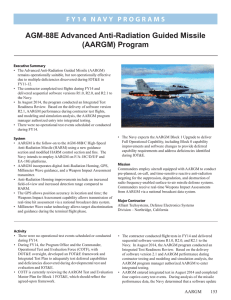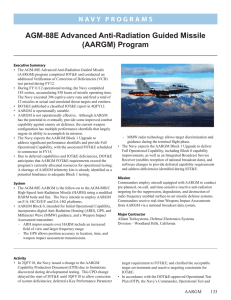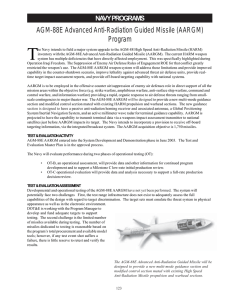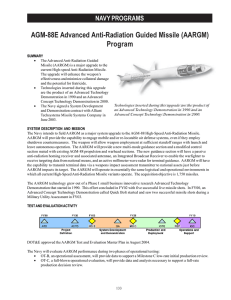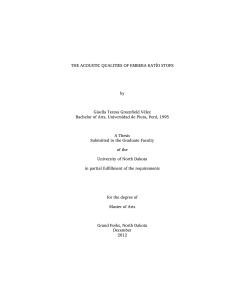AGM‑88E Advanced Anti‑Radiation Guided Missile (AARGM) Program
advertisement
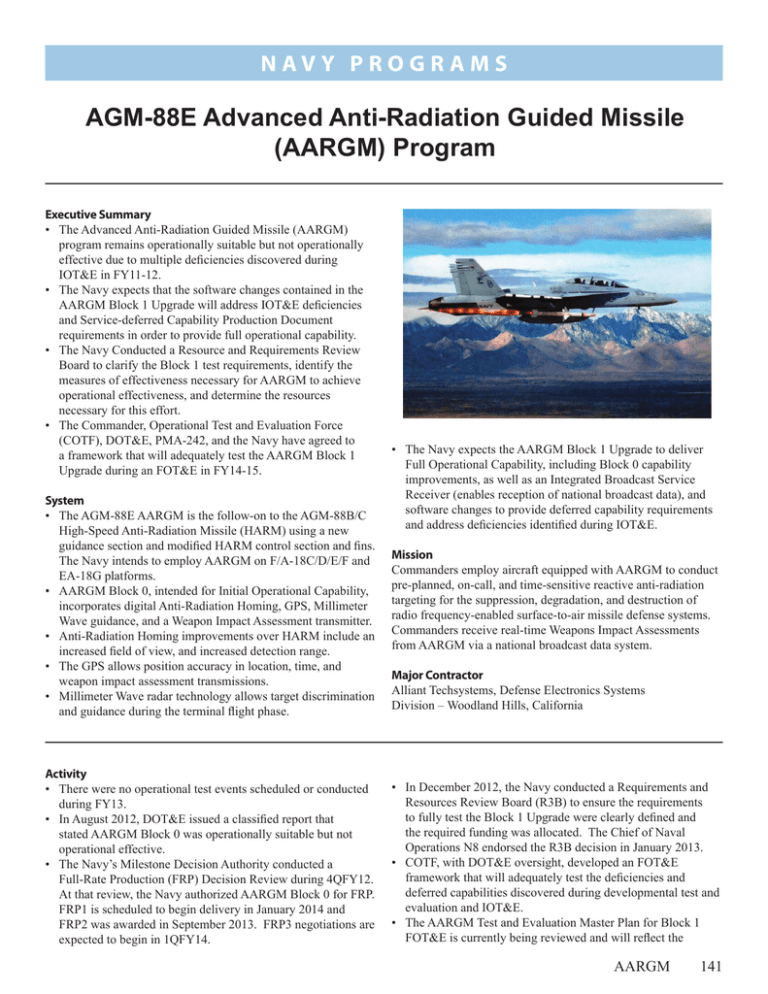
N av y P R O G R A M S AGM-88E Advanced Anti-Radiation Guided Missile (AARGM) Program Executive Summary • The Advanced Anti-Radiation Guided Missile (AARGM) program remains operationally suitable but not operationally effective due to multiple deficiencies discovered during IOT&E in FY11-12. • The Navy expects that the software changes contained in the AARGM Block 1 Upgrade will address IOT&E deficiencies and Service-deferred Capability Production Document requirements in order to provide full operational capability. • The Navy Conducted a Resource and Requirements Review Board to clarify the Block 1 test requirements, identify the measures of effectiveness necessary for AARGM to achieve operational effectiveness, and determine the resources necessary for this effort. • The Commander, Operational Test and Evaluation Force (COTF), DOT&E, PMA-242, and the Navy have agreed to a framework that will adequately test the AARGM Block 1 Upgrade during an FOT&E in FY14-15. System • The AGM-88E AARGM is the follow-on to the AGM-88B/C High-Speed Anti-Radiation Missile (HARM) using a new guidance section and modified HARM control section and fins. The Navy intends to employ AARGM on F/A-18C/D/E/F and EA-18G platforms. • AARGM Block 0, intended for Initial Operational Capability, incorporates digital Anti-Radiation Homing, GPS, Millimeter Wave guidance, and a Weapon Impact Assessment transmitter. • Anti-Radiation Homing improvements over HARM include an increased field of view, and increased detection range. • The GPS allows position accuracy in location, time, and weapon impact assessment transmissions. • Millimeter Wave radar technology allows target discrimination and guidance during the terminal flight phase. Activity • There were no operational test events scheduled or conducted during FY13. • In August 2012, DOT&E issued a classified report that stated AARGM Block 0 was operationally suitable but not operational effective. • The Navy’s Milestone Decision Authority conducted a Full-Rate Production (FRP) Decision Review during 4QFY12. At that review, the Navy authorized AARGM Block 0 for FRP. FRP1 is scheduled to begin delivery in January 2014 and FRP2 was awarded in September 2013. FRP3 negotiations are expected to begin in 1QFY14. • The Navy expects the AARGM Block 1 Upgrade to deliver Full Operational Capability, including Block 0 capability improvements, as well as an Integrated Broadcast Service Receiver (enables reception of national broadcast data), and software changes to provide deferred capability requirements and address deficiencies identified during IOT&E. Mission Commanders employ aircraft equipped with AARGM to conduct pre-planned, on-call, and time-sensitive reactive anti-radiation targeting for the suppression, degradation, and destruction of radio frequency-enabled surface-to-air missile defense systems. Commanders receive real-time Weapons Impact Assessments from AARGM via a national broadcast data system. Major Contractor Alliant Techsystems, Defense Electronics Systems Division – Woodland Hills, California • In December 2012, the Navy conducted a Requirements and Resources Review Board (R3B) to ensure the requirements to fully test the Block 1 Upgrade were clearly defined and the required funding was allocated. The Chief of Naval Operations N8 endorsed the R3B decision in January 2013. • COTF, with DOT&E oversight, developed an FOT&E framework that will adequately test the deficiencies and deferred capabilities discovered during developmental test and evaluation and IOT&E. • The AARGM Test and Evaluation Master Plan for Block 1 FOT&E is currently being reviewed and will reflect the AARGM 141 N av y P R O G R A M S agreed-upon framework. The Block 1 Upgrade is intended to complete testing on deferred Capability Production Document capabilities, correct deficiencies identified in IOT&E, and provide derivative benefits. Assessment • The FY13 status remains unchanged from the FY12 report. • In 2012, the Navy, without DOT&E consent, modified the approved test scenario to alleviate a classified deficiency, and proceeded with two live missile firings. Due to the modification of the test scenario, DOT&E assessed those missile firings to be operational failures. With that exception, the AARGM Block 0 testing was adequate to support an evaluation of the weapon system’s operational effectiveness and operational suitability. • AARGM Block 0 is operationally suitable. Although the weapon demonstrated poor reliability during IOT&E, the program addressed the primary deficiency affecting reliability and satisfactorily demonstrated this during the verification of correction of deficiencies test period in FY12. • AARGM Block 0 is not operationally effective. The details of these deficiencies are detailed in the classified DOT&E IOT&E report published in August 2012. • Sequestration is currently affecting FOT&E planning. Reductions in funding in FY14 could delay FOT&E later into FY15 or possibly FY16. 142 AARGM Recommendations • Status of Previous Recommendations. The FY12 recommendation to limit FRP quantities until operational effectiveness is properly demonstrated is no longer valid as the Milestone Decision Authority made the FRP decision in 4QFY12, and the Navy acquired additional lots of FRP missiles. The Navy intends to upgrade all Block 0 FRP missiles with Block 1 Upgrade at the completion of the FOT&E. The upgrade is a software-only upgrade and will be completed at the squadron level. The Navy addressed the second recommendation regarding telemetry kits to satisfy Block 1 FOT&E requirements. • FY13 Recommendation. 1. The Navy should adequately program and fund the AARGM Block 1 FOT&E. In the event full funding is not available, the Navy should prioritize targets and conduct FOT&E on the higher priority targets. The Navy should then develop an additional FOT&E period to fully test the remaining lower-priority targets, when funding becomes available.
